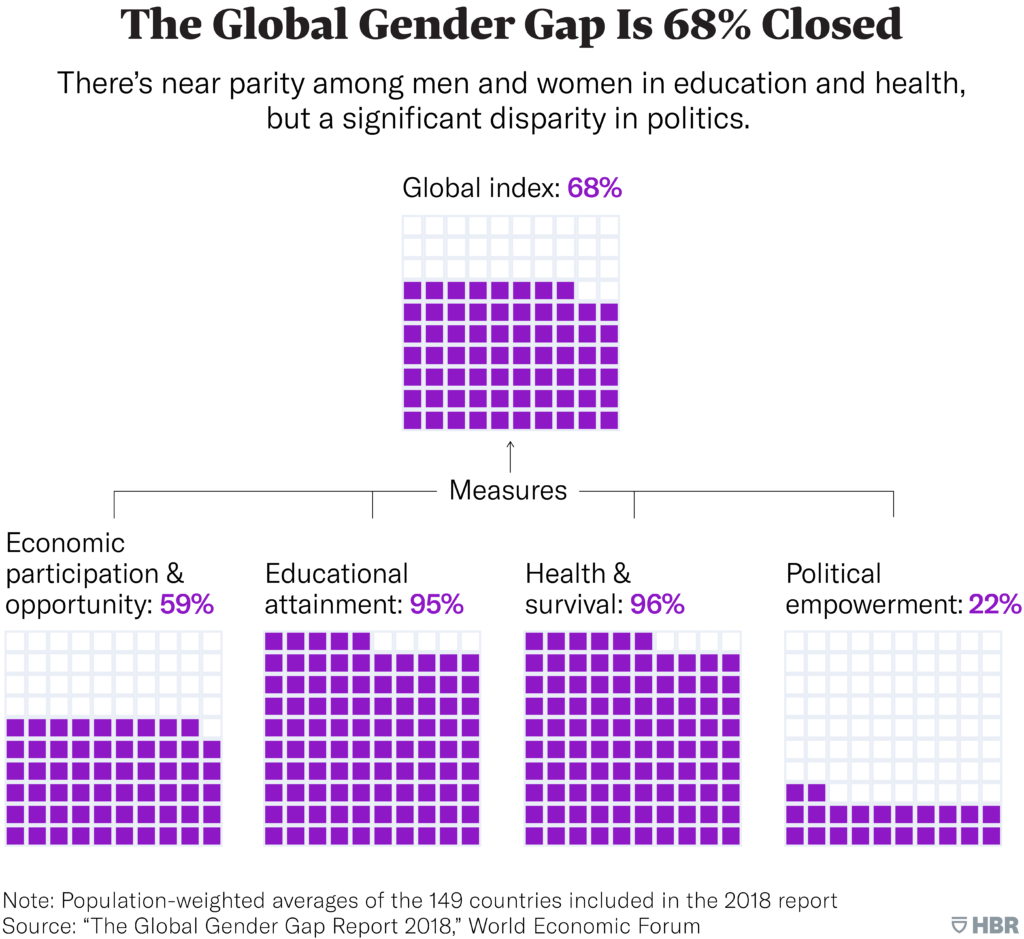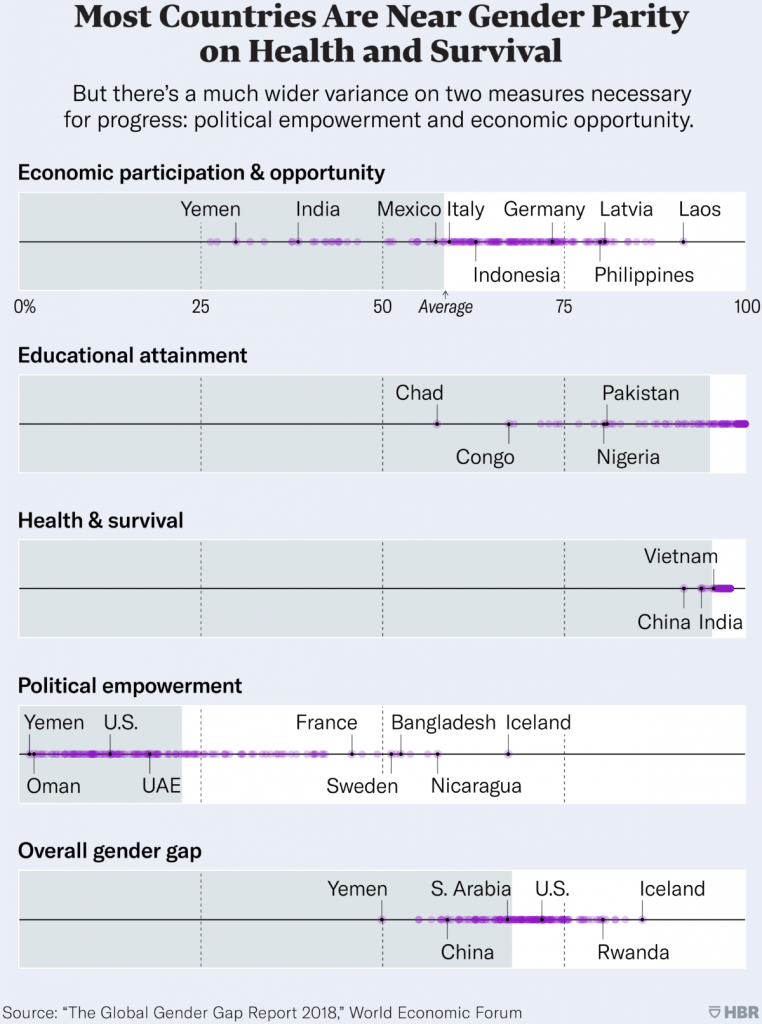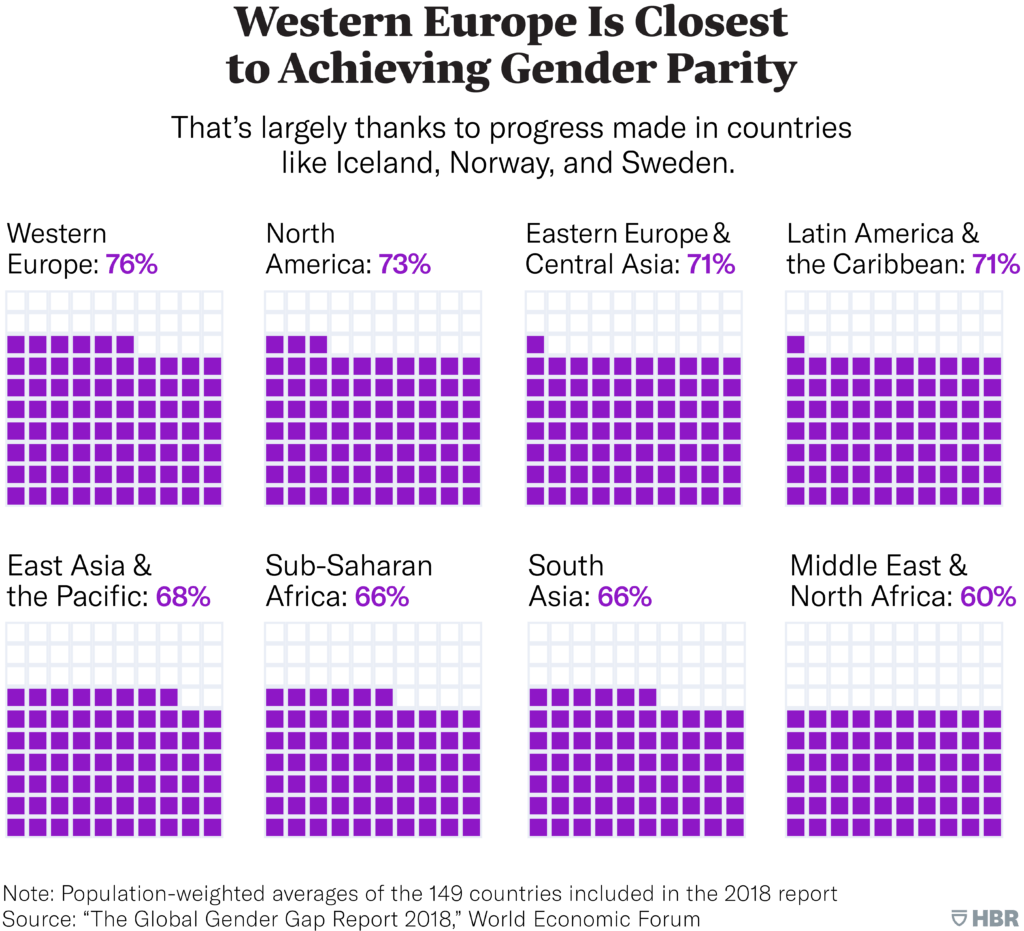Gender Gap forever?
Just how long will it take to achieve gender equality around the world? While the World Economic Forum predicts the United States won’t reach this mark for more than two centuries, other countries are further along — and several could reach equality within our (or our children’s) lifetime. But in most nations, and on many key metrics, equality is still a long way away. Looking at the data reveals exactly where women are furthest behind — largely on measures of power and influence — which can help us tackle those specific areas.
The WEF’s Global Gender Gap Report, published annually since 2006, analyzes 149 countries on four dimensions critical to equality:
Economic participation and opportunity: labor-force rates, earned-income ratios for women and men, and gender ratios in legislative, managerial, and professional work
Educational attainment: women’s and men’s access to primary, secondary, and tertiary education
Health and survival: sex ratio at birth (to account for countries where male children are strongly preferred) and the difference in men’s and women’s life expectancies
Political empowerment: gender ratios in ministerial and parliamentary positions, and the ratio of years that women and men have served as presidents or prime ministers in the last half century
Below is a closer look at each of these dimensions, followed by how different regions compare.
GENDER EQUALITY GAPS BY DIMENSION
The gaps between men and women across all of these measures are slowly getting smaller. In 2018 the WEF report showed that 68% of the overall gap is closed, a slight rise from about 65% in 2006. Much of that has to do with educational attainment and health, where gender differences have almost vanished. But two key areas of power and influence still haven’t caught up: political empowerment and economic participation and opportunity. Women hold a mere 34% of managerial positions worldwide, and fewer than 10% of countries have women as heads of state.
So while women are increasingly educated and healthy, they are rarely included in decision making that affects them.


Only one of the four measures rose between 2017 and 2018: economic opportunity, largely due to a general boost in women’s income and to an increase in the number of women in the tech space. All other categories, while generally on the rise since 2006, took a slight dip. In particular, women’s political empowerment dropped after almost a decade of slow growth. The reason? Stalled or declining representation of women in political office in the West.

Another way to look at each index is by country. When you compare the dispersion of countries along each of the four measures, you can see where various nations land. Educational attainment and health are considerably more clustered, while there is wider disparity between countries on economic opportunity and political empowerment.
It’s worth noting the United States is on the low end when it comes to political empowerment, ranking 98th. Iceland leads on this particular measure, though even it has seen a slight decrease in the number of women legislators since 2017. Nicaragua, which ranks second, currently has the most parity between men and women in government.


GENDER EQUALITY GAPS BY REGION
Taking a different lens, many of the gaps aren’t dramatically large when you compare regions: Western Europe and North America have closed the gap the most in recent years, while South Asia and the Middle East and North Africa have closed it the least.


In some ways, this is a reflection of the countries in these regions. Western European countries hold half of the spots in the top 10: Iceland (1st), Norway (2nd), Sweden (3rd), Finland (4th), and Ireland (9th). (Rounding out the leaders are, in order, Nicaragua, Rwanda, New Zealand, the Philippines, and Namibia.) The U.S. comes in at 51st, China is 103rd, and India is 108th. The bottom three are Yemen (149th), Pakistan (148th), and Iraq (147th). And yet even leading and trailing regions have discrepancies within them. In Western Europe there is a 3.4% difference in educational attainment between the top-ranked and bottom-ranked countries.
Then there’s the pace of progress across regions, which is slowly inching forward. Most regions have risen or stayed the same — except for North America, which dipped in previous years before rising slightly in 2018. This past year also saw slight dips for Sub-Saharan Africa and South Asia, while Latin America and the Caribbean saw the largest improvements between 2017 and 2018.

All of this leads to both good and bad news about how soon gender equality will happen. The numbers, by region, are below.


Fifteen countries are on track to close the gap in the next 50 years, including France (22 years) and Iceland (23 years). Thirty-five countries should do so within a century, including Canada (51 years), Switzerland (54 years), and Saudi Arabia (76 years); the World Economic Forum points out that a child born today may see parity in their lifetime in these places. In more than half of the countries in the index, however, a child born today will never see gender parity: It’s estimated to take 208 years in the United States — and up to 500 years in Pakistan and Iran.THE BIG IDEA
About the authors: Gretchen Gavett is a senior associate editor at Harvard Business Review. Matt Perry is the senior graphics editor at Harvard Business Review.



